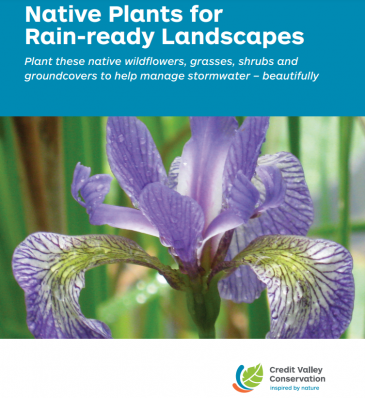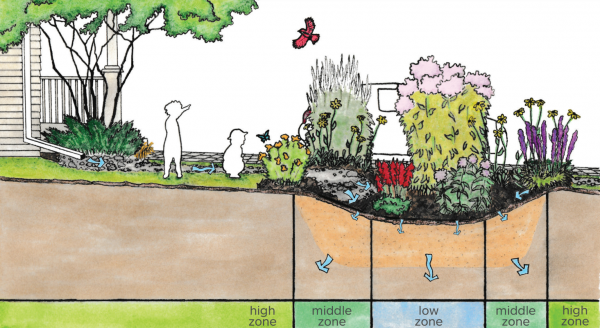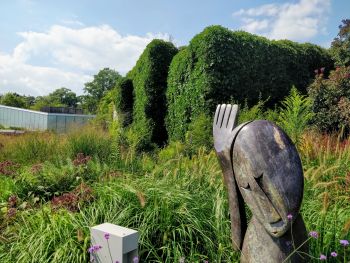Plant lists
Vegetation is a big opportunity to maximize the co-benefits of biodiversity and amenity in LID practices. Planting plans can be formalized or naturalized to suit the surrounding style. In addition to aesthetic qualities, plants have specific functions in several LID practices. These include promotion of infiltration, treatment of pollutants[1] and stabilization of soil. When selecting plants for an LID practice, aim for species with high functionality, survivability, suitability and availability. Landscape professionals should use these lists as guides, taking into consideration the appropriate planting zone, the size of the planting area versus size of the plant at maturity, tolerances to drought or periodic inundation, maintenance requirements and adaptability.
Rain-Ready Landscapes[edit]
Landscapes that use native plants; including trees, graminoids, shrubs/bushes, tall grasses and perennials to aid is both capturing and 'soaking up' rainwater can help reduce flood risk, build climate resilience, improve water quality and provide habitat for pollinators. There are 3 major types of 'rain-ready landscapes' to choose from when adopting the use of plants in LID practices:

- Rain Gardens - planted shallow depression with rainwater collected from roofs, rain barrel overflows/rainwater harvesting devices and allows water to drain into the surrounding ground within 24 hrs. Generally landscaped with a variety of suitable native plants, that can also benefit pollinator species.
- Soakaways - Gravel filled pit in this case to collect and transport water from a downspout or rainwater harvesting practice to fit lot-level properties and generally landscaped with river stone, native plants and other decorative rocks or sod. Allows water to drain into the surrounding ground within 24 hrs.
- Bioswales & Bioretention - long trench with gently sloping sides that collects rainwater from impermeable surfaces generally parking lots, boulevards, right-of-ways, etc.) and drains water within 24 hrs. Generally tall grasses and long grasses are planted in the middle and along the bottom part of the swale to aid in reducing the velocity of water entering the practice and to help filter out pollutants.
- Stormwater Tree Trenches - linear tree planting structures that feature supported impermeable or permeable pavements that promote healthy tree growth while also helping to manage runoff. They are often located behind the curb within the road right-of-way and consist of subsurface trenches filled with modular structures and growing medium, or structurally engineered soil medium, supporting overlying sidewalk pavement. Retains and filters out pollutants and salt from urban sites and then allows water to drain into the local municipal storm swear system after a major storm event to help reduce peak flow of water entering into the system and reduces the likelihood of an overwhelmed storm sewer or local surcharge.[3]
How to Choose the Right Plants[edit]
To help you select appropriate plants for your site, we've developed tables to indicate the suitability for use in LID features (see page links under Plant Selection).
- For resilient and robust planting, native species which can tolerate periods of drought and periodic inundation are recommended.
- Woody and evergreen plants should not be planted in any portions of the LID facility to be used for snow storage during winter months.
- Trees and shrubs should be offset from inlets and overflow outlet locations, and lowest-elevation portions of the LID facility, where sediment, trash and natural debris will accumulate, to ensure access for completing routine inspection and maintenance tasks is not hindered.
- Trees should not be planted directly over underdrain perforated pipes and may be better located at the perimeter of LID facilities instead.
- While it is not always necessary to use an exclusively native planting palette, invasive non-native plants (i.e., invasive exotics) should not be planted in LID practices.
Plant Selection[edit]
Note: These pages contain a lot of images and content and will likely take a little longer to load than usual.
Planting Zones[edit]

There are three primary zones in a 'rain-ready' LID feature/landscape. These can be seen below:
- Low Zone: Lowest area of the feature, along the bottom of the planted area and is the area that gets fully inundated with water during rain events or heavy runoff leveles enter. Plants that should be chosen here prefer moist soils and should be rated a "3" when referencing our STEP tables above.
- Middle Zone: Middle zone of feature, which can still possess higher soil moisture levels, but that doesn't persist as long as the levels seen in the Low Zone. Plants that should be selected for this area prefer alternating wet and drier periods and should be rated a "2" when referencing our STEP tables above.
- High Zone: High area of the feature in question and as a result its soil moisture levels are very low and it is the driest section of the planted area. Plants selected should have good drought tolerance and should be rated a "1" when referencing our STEP tables above..
Plant Characteristics[edit]
Soil moisture[edit]
Plant species are adapted to specific levels of moisture to achieve establishment and sustained growth. Soil moisture has been characterized by three categories: dry (1), moist (2) and wet (3). Some plants can tolerate a wide range of moisture regimes, whereas others perform optimally in a more narrow range of soil moisture conditions. Species ranked with a dash between two numbers can tolerate a range of conditions.
Shade tolerance[edit]
Plant species react differently to varying levels of sunlight and shade. Plant adaptations to these parameters are referred to in terms of degree of exposure. Most of the LID practices will be installed in newly developed areas, thereby providing exposure to full sun, meaning at least 6 full hours of direct sunlight for plantings. As trees develop over several years, or if an LID practice is installed in an area where there are existing trees or buildings providing partial shade, plants adapted to 3 to 6 hours of sunlight exposure should be used. Plants tolerant of full shade require less than 3 hours of direct sunlight each day. However, some shade-adapted species come into leaf early in the growing season in order to take advantage of full sunlight before tree leaves emerge and create shade.
Our tables indicate whether the species in question is tolerant of shade at all. For more information, consult the sources listed below.
Drought tolerance[edit]
These categories represent broad generalisations regarding drought tolerance.
Salt tolerance[edit]
The low, medium and high categories indicate the tolerance of plant species to salt exposure and/or uptake. Plant species with low salt tolerance should not be used in any LID practice receiving runoff from salted roads and parking lots. Species with medium salt tolerance can be utilised in LID practices that will be receiving road runoff but should not be in the line of salt spray or be receiving the bulk of the runoff. Species with high salt tolerance should be planted in LID practices that receive road or parking lot runoff that routinely contains road salt. Few plants are truly halophytic or “salt-loving”. In most cases, elevated salt levels are temporary and precipitation quickly dilutes and removes salt from the soil profile. The plant lists below include recommended species for LID practices likely to receive road or parking lot runoff.
Compaction and pollution tolerance[edit]
Development nearly always causes compaction of on-site soil, and bioretention facilities in road-right-of-ways should be pollution tolerant.
STEP stars[edit]
These are species which have demonstrated good performance in projects designed, installed and monitored by the Sustainable Technologies Evaluation Program.
| Plant characteristic | Potential benefit to LID performance |
|---|---|
| Plant mass | Higher biomass consumes more nutrients (decreases nutrient discharge from bioretention) and increases transpiration rate. |
| Growth rate | Higher growth rate consumes more nutrients, particularly in combination with root characteristics as below. |
| Root lipid content | Higher root lipid content has been associated with increased plant uptake of organic contaminants such as polyaromatic hydrocarbons (PAHs) |
| Root length | Longer roots are associated with plants consuming more nutrients and preserving hydraulic conductivity of the filter media. |
| Root mass and thickness | Larger overall root mass and many dense fine roots are associated with increased nutrient uptake by plants. Thicker roots help to preserve hydraulic conductivity of the media. |
| High-nutrient tolerance | Plants adapted to high nutrient environments are likely to uptake nutrients at a higher rate. |
External resources[edit]
| Organization | Coverage | Types of Material | Website |
|---|---|---|---|
| Credit Valley Conservation | Ontario | Native Grasses, Ferns, Shrubs, Small Trees | https://cvc.ca/wp-content/uploads/2022/03/com_lo_rain-ready-guide_20220328-FINAL3.pdf |
| Watersheds Canada | Canada / Ontario | Native Grasses, Ferns, Shrubs, Trees, Vines | https://watersheds.ca/plant-database/ |
| Columbia University, University of Maryland, Smithsonian Institute1 | North eastern USA and Canada | Native and non-native trees and shrubs | http://leafsnap.com/species/ |
| Louisiana State University | USA | Grasses, Ferns, Herbaceous, Shrubs, Trees, Vines, Ornamental | http://onlineplantguide.com/Index.aspx |
| United States Department of Agriculture | USA | Grasses, Ferns, Herbaceous, Shrubs, Trees, Vines, Ornamental | https://plants.usda.gov/java/ |
1. Leafsnap is an on-line field guide, available as a free mobile app that uses visual recognition software to help identify tree species from photos of their leaves, flowers and fruits. [6]
See Also[edit]
- Planting design
- Bioretention
- Bioswales
- Enhanced grass swales
- Green roofs
- Rain gardens
- Stormwater planters
- Stormwater tree trenches
- Swales
- Vegetated filter strips
- Wetlands
- ↑ Hunt, W. F., Lord, B., Loh, B., & Sia, A. (2015). Plant Selection for Bioretention Systems and Stormwater Treatment Practices. Singapore: Springer Singapore. https://doi.org/10.1007/978-981-287-245-6
- ↑ CVC. 2022. Native Plants for Rain-ready Landscapes. Plant these native wildflowers, grasses, shrubs and groundcovers to help manage stormwater – beautifully. cvc.ca/GreenYourProperty. https://cvc.ca/wp-content/uploads/2022/03/com_lo_rain-ready-guide_20220328-FINAL3.pdf.
- ↑ CVC. 2022. Native Plants for Rain-ready Landscapes. Plant these native wildflowers, grasses, shrubs and groundcovers to help manage stormwater – beautifully. cvc.ca/GreenYourProperty. https://cvc.ca/wp-content/uploads/2022/03/com_lo_rain-ready-guide_20220328-FINAL3.pdf.
- ↑ CVC. 2022. Native Plants for Rain-ready Landscapes> plant these native wildflowers, grasses, shrubs and groundcovers to help manage stormwater - beautifully. cvc.ca/GreenYourProperty. https://cvc.ca/wp-content/uploads/2022/03/com_lo_rain-ready-guide_20220328-FINAL3.pdf
- ↑ Muerdter, C.P., C.K. Wong, and G.H. LeFevre. 2018. Emerging investigator series: the role of vegetation in bioretention for stormwater treatment in the built environment: pollutant removal, hydrologic function, and ancillary benefits. Environ. Sci. Water Res. Technol. 4(5): 592–612. doi: 10.1039/C7EW00511C.
- ↑ Columbia University, University of Maryland, Smithsonian Institute. 2018. Leafsnap. http://leafsnap.com/species/
